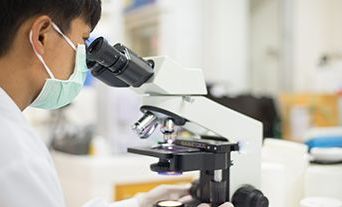Care, quality and expertise are the values that underpin the service that NHS Blood and Transplant (NHSBT) provides. They guide and inspire us to be the best in what we do. Our main ambition is to save and improve lives by delivering the priorities in the recently published corporate strategy.
NHSBT’s strategy
One of our key priorities is to ‘drive innovation to improve patient outcomes’. This builds on NHSBT’s long and proud history of cutting-edge research and development. To remain world leaders in transfusion and transplantation, we will drive improvements by focusing our efforts on those innovations that offer the greatest potential to improve patient outcomes.
Genotyping is developing at scale and pace. We already use typing to match white blood cells, stem cells and organs to recipients. We now want to implement cost-effective, accurate, large-scale genotyping of red cell and platelet donors. By developing and adopting new genotyping technology, we will be better able to match blood for multi-transfused recipients, and organs and stem cells for transplantation.
More precise matching of red cells will ultimately lead to better clinical outcomes, particularly for patients who require chronic transfusion therapy. This will particularly benefit sickle cell patients who are at more risk of making antibodies against transfused red cells.
The gap between supply and demand for solid organs continues to grow. We will explore the use of organ perfusion technologies to maintain and enhance the quality of organs, improve organ preservation and increase organ utilisation. This will enable more patients to receive the transplant they need, especially if we can develop rapid, precise near-donor testing.
We also want to make it simpler and quicker for hospitals to get blood products to patients and reduce the risk of complication. We will do this by focusing our efforts on the development of universal blood components and whole blood.
Building and analysing new data sets to track and demonstrate the impact of our interventions will lead to better understanding and improved outcomes. We already do this successfully for solid organs and will build similar systems for people who receive blood or stem cells. We will use data to improve outcomes through:
- better matching blood donors and patients using genotyping
- developing the algorithms to match donors and patients
- undertaking clinical trials to show this works.
Investment in research and development will be critical if we are to remain world leaders in transfusion and transplantation medicine. We believe that, by providing resources for data, genomics and research and development (R&D), we can improve outcomes and reduce health inequalities.
The gap between supply and demand for solid organs continues to grow. We will explore the use of organperfusion technologies tomaintain and enhance the quality of organs, improve organ preservation andincrease organ utilisation.
Blood and Transplant Research Units
We can achieve our strategic and scientific goals by working with the National Institute for Health Care Research (NIHR) and others by investing in R&D and driving innovation into practice.
In April 2022, NHSBT launched five Blood and Transplant Research Units (BTRUs) across blood, organ, plasma and stem cells. The BTRUs, which are partnerships between NHSBT and leading universities, aim to provide new technologies, techniques or insights that will benefit donation, transfusion and transplantation. These BTRUs will be an important vehicle to bridge the gap between R&D and translation to clinical practice.
Many of the work strands in the new units could result in new technologies and practices that can then be delivered at scale by NHSBT, helping to save and improve even more lives. To maximise the value and impact from our research, we must also bridge the gap between our R&D and operational teams to accelerate the translation of innovation into practice.
Much of the work in the BTRUs will be aimed at reducing health disparities and improving access to new treatments, which aligns with NHSBT’s corporate strategy and overall ambition to save and improve lives. The products could be manufactured at the latest NHSBT sites including major new centres such as the new cellular therapies laboratories in Barnsley and the forthcoming Clinical Biotechnology Centre in Bristol.
The BTRUs are funded by £16 million from the NIHR and £4 million from NHSBT, with research goals set to meet NHSBT’s requirements, to be delivered between 2022 and 2027.
Precision cellular therapeutics
This BTRU was established in partnership with the University of Oxford, working in collaboration with the University of Birmingham and University Hospitals Birmingham NHS Foundation Trust led by Professor Ronjon Chakraverty.
The aim of this BTRU is to develop new kinds of cell therapies such as CAR-T for blood disorders and blood cancer, and improved systems for following up patients receiving treatment to better support their care. For example, it is important that patients from all communities benefit from cell therapies, therefore the team will seek to better understand how patients access the newer cell therapies and how they perceive the benefits of treatment. The team will also develop new digital technologies that improve care by enhancing interactions between the patients and their doctors and nurses.


Data-driven transfusion practice
This BTRU is partnered with the University of Oxford, working in collaboration with the University of Leeds, Queen Mary University of London, with Guy's and St Thomas’ NHS Foundation Trust, and further hospitals led by Professor Simon Stanworth.
Blood transfusions save lives but must be used appropriately and like all medical interventions they carry a risk. Around 20–25% of blood transfusions are given outside of clinical guidelines. Data-driven approaches – using actual data at all steps in the transfusion chain – can offer ways to improve transfusion practice. One way the team hopes to achieve this is by working with hospital teams across the country to develop a linked electronic pathway between hospitals and from donors to patients receiving blood, to monitor and improve clinical use of transfusion.
Organ donation and transplantation
Led by Professor Michael Nicholson, this BTRU is jointly partnered with Newcastle University and the University of Cambridge.
The goal of BTRU research is to deliver a step change in understanding how best to deliver transplant services to the UK population, ensuring more people get the transplants they need and go on to live healthy and fulfilling lives.
The BTRU will test how modern perfusion machines, which keep organs alive outside the body, can increase the quality of organs available to allow delivery of new treatments to organs before transplantation and identify the best national system for delivering organ perfusion. It will also increase the use of organs by improving tissue-matching to enable transplants in difficult-to-match patients including women, those needing a re-transplant and ethnic minority groups.
Improvements will be sought in how long transplanted organs last and to improve recipients’ heart health, so they live longer with a working transplant. The BTRU will also use cutting-edge technology to measure genes and proteins in donor organs to predict long-term individual outcomes. It will take the views of transplant patients and carers to identify the best ways of describing quality of life after transplantation. This will be invaluable in researching changes in practice that improve quality of life.
Donor health and behaviour
This BTRU is partnered with the University of Cambridge, working in collaboration with the University of Nottingham and the University of Oxford, led by Professor Emanuele Di Angelantonio.
The evidence base underpinning blood donation is underdeveloped. The research aims to improve the safety and efficiency of blood donation. The BTRU will conduct research to address major challenges identified by NHSBT, such as finding ways to encourage a more ethnically diverse range of people to donate blood, developing new methods for recruiting and retaining donors, promoting safe and effective donation practices, and identifying risks of adverse health effects of blood donation.
Genomics to enhance microbiology screening Partnered with the University of Oxford, this BTRU will work in collaboration with University College London and the UK Health Security Agency, led by Professor Peter Simmonds.
This BTRU will evaluate and provide solutions for current threats to the microbiological safety of blood, organs and derived products used to treat patients. The team will see how new, large-scale genetic testing methods – collectively known as high throughput sequencing – can detect and often fully genetically characterise infectious agents present in patient and donor samples.
Blood donors provide a valuable cross-section of the adult population with which to pick up early signs of emerging infections in the UK. The team will use a donation bioarchive to test anonymised samples for novel pathogens using high throughput sequencing. The project will additionally link with surveillance programmes by public health organisations, potentially developing larger early warning systems in areas where viruses are detected.
Summary
Training PhD students, supporting patient and public involvement and engagement activities, and ensuring that research findings are translated into benefits for donors and NHSBT are integral to all the success of the BTRUs.
Dr Gail Miflin, Chief Medical Officer for NHSBT, said: ‘By collaborating with academia, these five new BTRUs will help us to deliver on our mission to ‘save and improve even more lives’, and drive innovation to inform future clinical practice and improve patient outcomes.’
To maximise the value and impact from our research, we will accelerate the translation of innovation into practice. The BTRUs will be an important vehicle for this in the longer term and, ultimately, deliver our vision of a world where every patient receives the donation they need.




